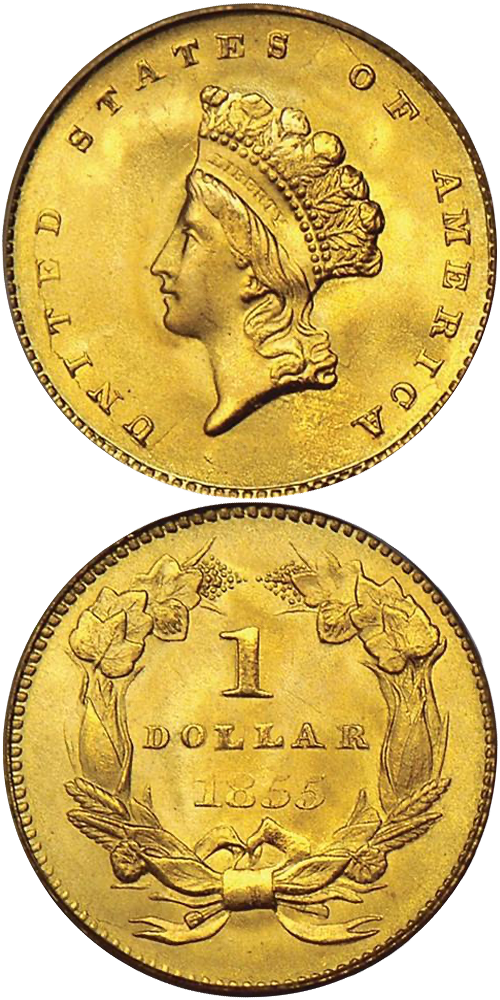1855 Gold Dollar
The Act of February 21, 1853, returned silver coinage to circulation in the East and Midwest by reducing the weight of the half dime, dime, quarter and half dollar to the point where their face value exceeded their bullion value. The coins were made subsidiary and were able to circulate freely in those areas for the first time since 1849. Mintages for all denominations from the half dime through the half dollar increased dramatically in 1853, with the Philadelphia Mint in particular churning out huge quantities of these coins. The effects on the gold dollar were significant and immediate, perhaps not surprising since the gold dollar was created in 1849 as a new denomination for coining California metal and also to help fill the void in commercial channels left by the withdrawal of silver.
With silver coins returning to circulation in large numbers, the need for the gold dollar diminished rapidly. Yearly mintages at the Philadelphia Mint tapered off and by 1858 and through the end of the decade that facility was producing fewer than 200,000 examples per year. (The mintage for the 1860 amounted to a mere 36,514 pieces.) Additionally, the gold dollar's small size was an issue, but with few alternatives in circulation during the early 1850s, the public was accepting.
In 1854 Chief Engraver James Barton Longacre prepared a new design with an enlarged diameter of 15 millimeters, more convenient than the earlier size. The weight of the denomination remained unchanged, so the coins were made slightly thinner. Unfortunately, the design that Longacre chose, although aesthetically pleasing, was in too high relief for the thinner planchets, and most examples displayed poor definition in and around the centers. The dies often clashed early and frequently during press runs, and many survivors exhibit numerous pronounced clash marks on one or (usually) both sides. The Mint abandoned the new design after only three years of production, and in the third -- 1856 -- only the San Francisco Mint struck examples of this type.
Known in numismatic circles as the Type II gold dollar, mintages were generous only at the Philadelphia Mint in 1854 and 1855. The New Orleans and San Francisco mints achieved only modest deliveries in 1855 and 1856, respectively, while production at both the Charlotte and Dahlonega facilities in 1855 were extremely limited (the 1855-D, for example, has an original mintage of just 1,811 pieces). The 1854 and 1855 Philadelphia Mint issues are the obvious choices for representing this design in a gold type set and, indeed, examples are obtainable with ease in circulated grades. In lower Mint State grades the 1854 and 1855 issues are also plentiful, although the brevity of the type and its scarcity explains the premium enjoyed by these issues even in grades such as MS-61 and MS-62. The true rarity of the 1854 and 1855 Type II gold dollars emerges at and above the MS-65 level, where the striking problems combined with limited contemporary interest in preserving these coins explains the paucity of truly superb survivors.
In 1855 only 758,269 gold dollars were coined at the Philadelphia Mint while the three Southern branch mints turned out well under 70,000 pieces combined. Once silver quarters and half dollars were frequent sights again, the tiny gold dollar was no longer a desired coin.
The high relief of the Type II gold dollar caused problems when the pressure required to strike up the design also put undue stress on the thinner planchet. This caused the centers of the coin to be very poorly struck; in fact nearly every known example of the 1855 gold dollar is found with weakness at the 85 in the date and LL in DOLLAR. Even on specimens struck from fresh dies the 8 in the date is often very flat at the upper left portion of the top loop. This issue is particularly well known for being generally poorly struck and clashed dies are the rule rather than the exception. The design's technical difficulties proved to be its undoing and in 1856, a revised version with a larger bust designed in lower relief was introduced.
The high relief also proved to be detrimental in circulation, as the obverse was quick to show signs of wear, making Mint State examples particularly elusive. Maybe about a fifth of the estimated 5,000 to 7,500 survivors qualify as Mint State, of which only a couple dozen are at the Gem level.
The example to the left was sold by Stack's Bowers Galleries in the Summer 2022 Global Showcase Auction, where it realized $264,000.






